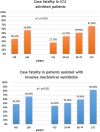Clinical presentation, therapeutic approach, and outcome of young patients admitted for COVID-19, with respect to the elderly counterpart
- PMID: 33555436
- PMCID: PMC7868661
- DOI: 10.1007/s10238-021-00684-1
Clinical presentation, therapeutic approach, and outcome of young patients admitted for COVID-19, with respect to the elderly counterpart
Abstract
There is limited information on the presenting characteristics, prognosis, and therapeutic approaches of young patients hospitalized for coronavirus disease 2019 (COVID-19). We sought to investigate the baseline characteristics, in-hospital treatment, and outcomes of a wide cohort < 65 years admitted for COVID-19. Using the international multicenter HOPE-COVID-19 registry, we evaluated the baseline characteristics, clinical presentation, therapeutic approach, and prognosis of patients < 65 years discharged (deceased or alive) after hospital admission for COVID-19, also compared with the elderly counterpart. Of the included 5746 patients, 2676 were < 65 and 3070 ≥ 65 years. All risk factors and several parameters suggestive of worse clinical presentation augmented through increasing age classes. In-hospital mortality rates were 6.8% and 32.1% in the younger and older cohort, respectively (p < 0.001). Among young patients, mortality, access to ICU and treatment with IMVwere positively correlated with age. Contrariwise, over 65 years of age this trend was broken so that only the association between age and mortality was persistent, while the rates of access to ICU and IMV started to decline. Younger patients also recognized specific predictors of case fatality, such as obesity and gender. Age negatively impacts on mortality, access to ICU and treatment with IMV in patients < 65 years. In elderly patients only case fatality rate keeps augmenting in a stepwise manner through increasing age categories, while therapeutic approaches become more conservative. Besides age, obesity, gender, history of cancer, and severe dyspnea, tachypnea, chest X-ray bilateral abnormalities, abnormal level of creatinine and leucocyte among admission parameters seem to play a central role in the outcome of patients younger than 65 years.
Trial registration: ClinicalTrials.gov NCT04334291.
Keywords: Coronavirus disease 2019; Intensive care unit; Invasive mechanical ventilation; SARS-CoV-2 infection.
Conflict of interest statement
The authors declare that they have no conflict of interest.
Figures




References
-
- WHO Director-General’s opening remarks at the media briefing on COVID-19: 11 March 2020. Published March 11, 2020. Accessed March 30, 2020. https://www.who.int/dg/speeches/detail/who-director-general-s-opening-re....
-
- Kowal P, Dowd JE. Definition of an older person. Proposed working definition of an older person in Africa for the MDS Project. World Health Organ Geneva. 2001;10(2.1):5188–9286.
Publication types
MeSH terms
Substances
Associated data
LinkOut - more resources
Full Text Sources
Other Literature Sources
Medical
Miscellaneous

